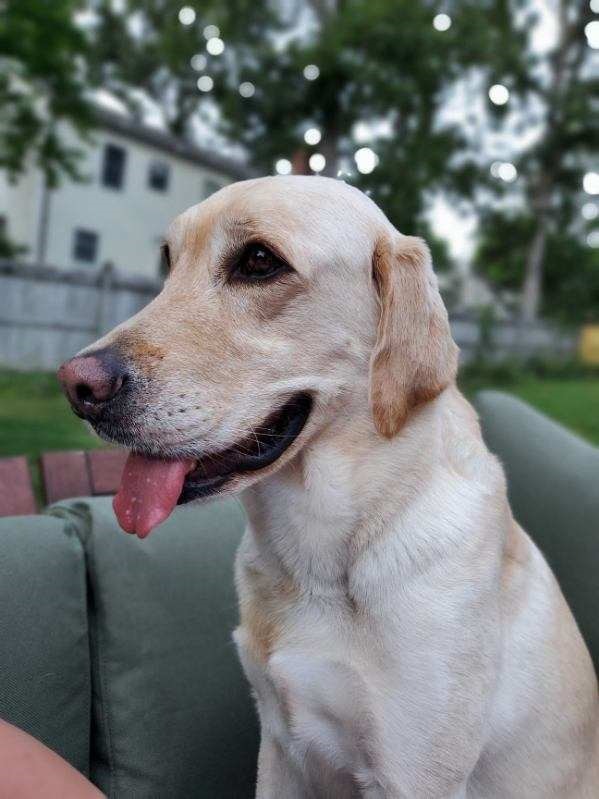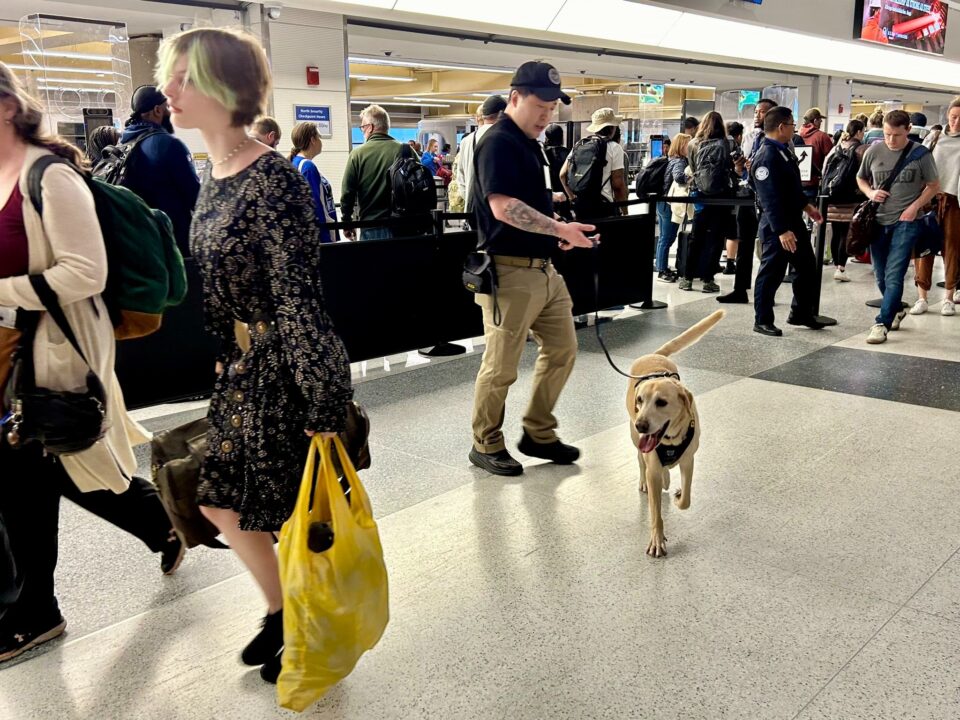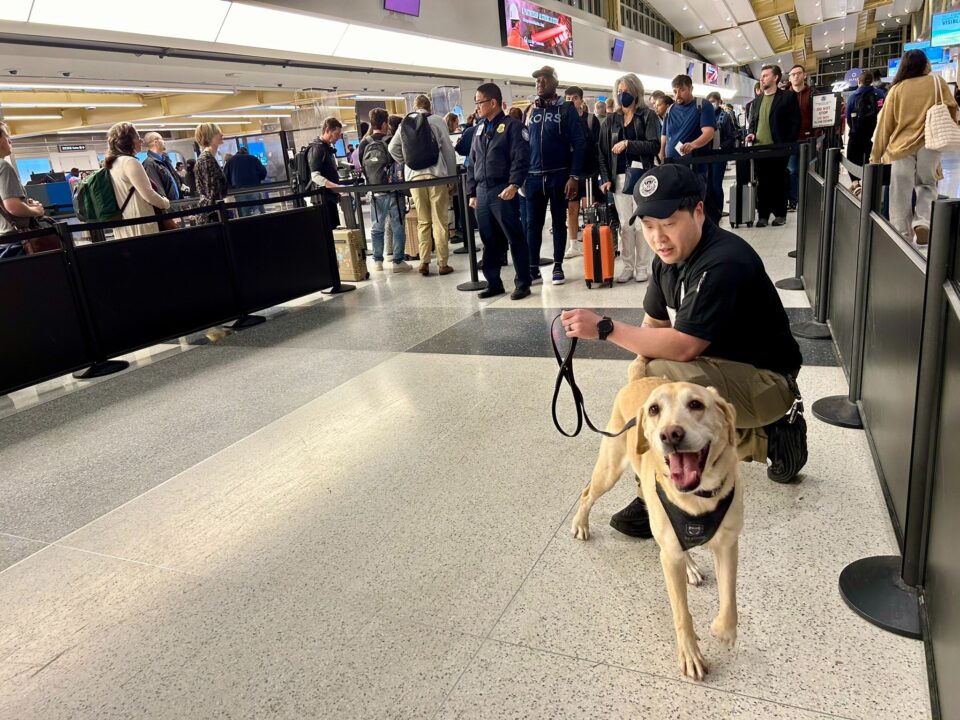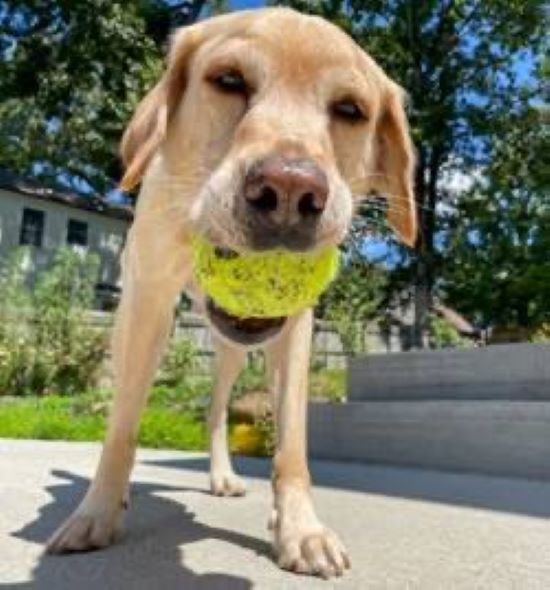An adorable eight-year-old Labrador retriever by the name of Messi has spent most of his life proudly working as a professional Transportation Security Administrator (TSA) agent.
Ever since he got hired at the Ronald Reagan Washington National Airport, Messi spent his work hours screening luggage for explosives, keeping the airport and everybody in it safe.
However, since he had so much fun, Messi failed to realize how fast time flies and, all of a sudden, he became eligible for retirement.
So, his incredible team of agents decided to surprise him with a very special gift.
Sweet Surprise

While working at the Washington airport, Messi was a very serious and determined worker, making him the best and the cutest colleague ever.
“He was born to work for TSA because he enjoys watching aeroplanes and playing in the grass at nearby Gravelly Point,” the TSA wrote in a press release shared with The Dodo.

Every single morning, Messi would burst into the airport with a smile stretching from ear to ear, dragging his handler, Peter, along with him.
Despite his routine consisting of tracking scents day in and day out, Messi approached each day with such enthusiasm, as if he was experiencing the thrill of his first day on the job every time.
But, Messi’s favorite part of his job was the celebratory tennis ball he would receive whenever he did a spectacular job!
So, for his last shift, his team decided to throw as many tennis balls as they could, leaving Messi completely shocked!
“A training aid was concealed in a large room and Messi, along with his handler, Peter, searched the room. When Messi ‘hit’ on the device, he was showered with tennis balls tossed his way by other canine handlers. Messi was thrilled!” the TSA wrote.

You can watch that incredible moment here:
Messi jumped along with the tennis balls, trying to catch at least one into his mouth. Some of his colleagues cheered him on while the others started blowing bubbles in his direction, making the moment so much more special.
After allowing him some time to play, Peter surprised him with a new and very meaningful harness.
“Peter then removed Messi’s ‘Do Not Pet’ patch from his harness, thus officially signaling that the dog was no longer a working canine and could be petted. There was no shortage of guests who were eager to pet the newly retired dog,” the TSA wrote.
The After Party
Messi loved soaking up all the love and attention he got from his amazing coworkers. It wasn’t a new occurrence for him to hear that he was a good boy; however, this time, he felt like he was the best boy in the whole wide world.
After celebrating his retirement with the rest of the TSA crew, Messi came back home with Peter and started his new chapter in life – retirement!
“The dog is ready to trade in his working vest for afternoons lounging on the sofa,” the TSA wrote.

The TSA agents at the Ronald Reagan Washington National Airport missed Messi as soon as he left, but the knowledge that he was finally able to be a real house dog filled their hearts with joy.
“Messi is a lovable and hard-working dog, who has enjoyed playing with a tennis ball after a busy day sniffing for any traces of explosives at the airport. Now he doesn’t have to wait to play with his favorite toy,” the TSA concluded.
Ever wondered about the fascinating world of canine dentition? Dogs, our loyal companions, have a set of pearly whites that play a crucial role in their daily lives. From flashing a friendly grin to munching on their favorite treats, a dog’s teeth are more than just tools for chewing. Understanding the dental makeup of these furry friends can provide insight into their overall health and behavior. As a seasoned dog enthusiast, you’re about to embark on a journey to unravel the mysteries behind how many teeth our four-legged pals actually possess.
As you observe your furry friend playfully gnawing on a toy or eagerly awaiting a tasty snack, have you ever stopped to ponder the number of teeth nestled in their mouths? Dogs’ dental structures are a marvel of nature, finely tuned to support their diverse dietary needs and playful antics. Get ready to peek into the world of canine oral anatomy and discover the secrets hidden within those adorable, slobbery smiles.
The Anatomy of Dog Teeth
Let’s get into the nitty-gritty of dog teeth! Understanding the anatomy of your furry friend’s dental structure can give you insights into their health and behavior.
- Types of Teeth in Dogs
Dogs have different types of teeth geared for specific purposes. They have incisors for nibbling, canines for tearing, premolars for crushing, and molars for grinding. - Deciduous vs. Permanent Teeth
Just like humans, dogs have two sets of teeth. They start with deciduous teeth as puppies, which are later replaced by a set of permanent teeth as they mature. - Number of Teeth in Dogs
Ever wondered how many teeth your dog has? Well, adult dogs typically have 42 teeth. This includes incisors, canines, premolars, and molars. However, puppies have fewer teeth than adult dogs. - Dental Health Importance
Proper dental care is crucial for your dog’s overall health. Keeping their teeth clean can prevent dental issues and maintain their well-being. - Behavioral Significance
Aside from eating, a dog’s teeth play a role in their behavior. Chewing helps to alleviate anxiety and keeps their jaws strong.
How Many Teeth Do Adult Dogs Have?
Adult dogs have a total of 42 teeth, which is a combination of different types serving various functions. Here’s a breakdown of the types and numbers of teeth in adult dogs:
- Incisors (Front Teeth): Adult dogs typically have 12 incisors, 6 on the top and 6 on the bottom. These teeth are used for grooming and nibbling.
- Canines (Fangs): Known as the sharp, pointy teeth, canines are used for tearing food and sometimes in self-defense. Dogs have a total of 4 canines, 2 on the top and 2 on the bottom.
- Premolars (Carnassial Teeth): These flat teeth are crucial for grinding and shearing food. Adult dogs have 16 premolars, 8 on the top and 8 on the bottom.
- Molars: Located at the back of the mouth, molars help in crushing and grinding food. Adult dogs have 10 molars, 4 on the top and 6 on the bottom.
It’s important to note that dental care is crucial for your furry friend’s overall health. Regular check-ups and proper dental hygiene can help prevent dental issues and ensure your dog maintains a healthy mouth.
Dental Health in Dogs
Maintaining your dog’s dental health is crucial for their overall well-being. Neglecting their teeth can lead to various issues, affecting their behavior and quality of life. Here’s what you need to know about dental care for dogs:
Importance of Dental Health
Good dental hygiene is essential to prevent dental diseases that can cause pain and discomfort to your furry friend. Regular check-ups and proper care can help avoid issues like plaque buildup, gum disease, and tooth decay.
Signs of Dental Problems
Watch out for signs of dental problems in your dog, such as bad breath, discolored teeth, excessive drooling, or difficulty eating. If you notice any of these symptoms, it’s important to consult a veterinarian for a proper diagnosis and treatment.
Dental Care Practices
Ensure your dog’s teeth are clean by brushing them regularly with a dog-specific toothbrush and toothpaste. Additionally, feeding them dental chews or toys designed to promote oral health can help keep their teeth strong and healthy.
Professional Dental Cleanings
Regular visits to the vet for professional dental cleanings are essential to remove tartar and plaque buildup that brushing alone may not eliminate. These cleanings can help prevent more severe dental issues and maintain your dog’s oral health.
Conclusion
Taking care of your dog’s dental health is an important aspect of being a responsible pet owner. By ensuring proper dental care practices and scheduling regular check-ups with the vet, you can help your beloved companion maintain a healthy and happy life.
Conclusion
So, there you have it – a deep dive into the world of dog teeth! Remember, taking care of your furry friend’s dental health is crucial for their overall well-being. With 42 teeth to look after, it’s essential to stay on top of regular check-ups and hygiene practices. By understanding the roles of different teeth and the importance of good dental care, you can help prevent issues like plaque buildup and gum disease. Whether it’s brushing their teeth or providing oral health-promoting toys, your efforts play a key role in keeping your dog happy and healthy. So, keep those pearly whites shining and your pup smiling!
Frequently Asked Questions
What is canine dentition?
Canine dentition refers to the arrangement and structure of a dog’s teeth. Dogs have different types of teeth, including incisors, canines, premolars, and molars, which serve various functions like biting, tearing, grinding, and crushing food.
Why is dental care important for dogs?
Dental care is crucial for a dog’s overall health and well-being. It helps prevent dental issues such as plaque buildup, gum disease, and tooth decay. Good dental hygiene can also improve a dog’s behavior and quality of life.
How many teeth do adult dogs have?
Adult dogs typically have 42 teeth that include incisors, canines, premolars, and molars. These teeth play essential roles in a dog’s ability to eat, groom, and maintain overall health.
What are the signs of dental problems in dogs?
Common signs of dental issues in dogs include bad breath, swollen or bleeding gums, changes in eating habits, pawing at the mouth, and visible tartar or plaque on the teeth.
How can I take care of my dog’s dental health?
Maintain your dog’s dental health by regular tooth brushing, providing dental treats and toys, scheduling professional dental cleanings, and ensuring a balanced diet that promotes good oral health.
What role do pet owners play in their dog’s dental care?
Pet owners have a crucial role in their dog’s dental care. They are responsible for implementing dental hygiene practices, scheduling veterinary dental check-ups, and providing a dental-friendly diet to support their dog’s oral health.
[no_toc]

Hey there, I’m Janet Brooks, a dog-loving student from California. I’m all about helping pups in need, especially those without homes. Me and my awesome friends work together to give shelter and love to stray dogs. Oh, and I also write blogs about dogs to share helpful info.